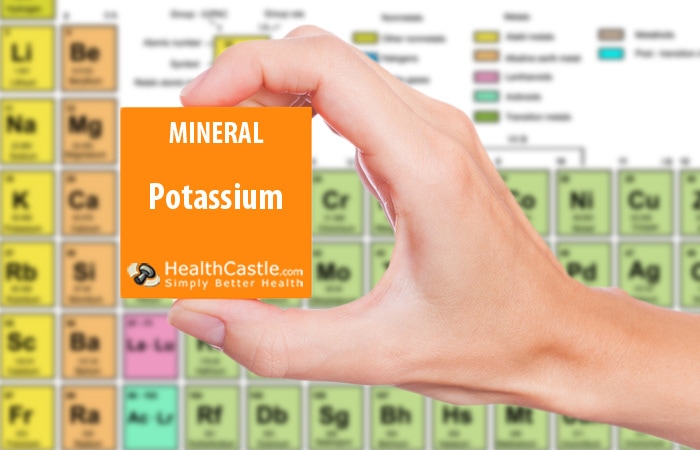
Written By: Carolyn Berry, RD
Title: Registered Dietitian
Alumni: University of British Columbia
Last Updated on:

Along with sodium, chloride, calcium, and magnesium, potassium is an electrolyte. Normal body function depends on tight regulation of potassium concentrations both inside and outside of cells
Table of Contents
The Dietary Reference Intakes (DRI) for potassium are shown below:
| Age Group | Recommended Dietary Allowance (RDA) per Day1 | Tolerable Upper Intake Level (UL) per Day |
| Adults | *No UL has been established for this nutrient | |
| 19 years and up | 4,700 mg | |
| Kids and Youth | ||
| 1 to 3 years | 3,000 mg | |
| 4 to 8 years | 3,800 mg | |
| 9 to 13 years | 4,500 mg | |
| 14 to 18 years | 4,700 mg | |
| Special Considerations | ||
| Pregnant women 14 years and up | 4,700 mg | |
| Lactating women 14 years and up | 5,100 mg |

Potassium is an electrolyte, meaning that it helps to conduct electrical charges in the body. As a result, potassium is crucial to heart function and plays a key role in skeletal and smooth muscle contraction, making it important for normal digestive and muscular function2. It also helps regulate fluids and mineral balance in and out of body cells and helps maintain normal blood pressure. Potassium may also reduce the risk of recurrent kidney stones and possibly bone loss as we age3.
Many enzymes require the presence of potassium for their activity. The activation of sodium, potassium-ATPase requires the presence of sodium and potassium. The presence of potassium is also required for the activity of pyruvate kinase, an important enzyme in carbohydrate metabolism4.
Hyperkalemia is when there is too much potassium in the blood. People with decreased kidney function are at greater risk for hyperkalemia5 because their kidneys are less efficient at eliminating potassium. Certain medications can also affect potassium levels.
Hypokalemia is when there is too little potassium in the blood. Diarrhea, vomiting, excessive sweating, malnutrition, malabsorption diseases (such as Crohn’s disease) can also cause potassium deficiency. Most people get all of the potassium they need from a healthy diet rich in vegetables and fruits.
Vegetables and fruit are some of the best sources of potassium. Whole grains, dairy products, lentils, meat and fish also have potassium.
| Food | Potassium per serving |
| Baked potato, 1/2 medium | 470 mg |
| Spinach, cooked, 1/2 cup | 419 mg |
| Yogurt, low fat, 3/4 cup | 402 mg |
| Tomato sauce, 1/2 cup | 364 mg |
| Avocado, 1/4 whole | 244 mg |
| Banana, 1/2 large | 243 mg |
| Strawberries, chopped, 1/2 cup | 230 mg |
| Broccoli, cooked, 1/2 cup | 229 mg |
| Cantaloupe, diced, 1/2 cup | 208 mg |
| Peanut butter, 2 tbsp | 179 mg |
| Wheat Bran | 171 mg |
In the United States: The Daily Value (DV) for potassium is 4,700 mg6 for ages 2 and older. The number you see on the Nutrition Facts label is a percentage calculated by dividing the amount of potassium in one serving of the food by the daily value. For example, a 1/2 cup of tomato sauce, which contains 364 mg, has 8% of the daily value (DV) for potassium. Foods providing 20% or more of the DV are considered to be high sources of a nutrient.
In Canada: The Daily Value for potassium is also 3,400 mg7. Listing the DV for potassium on the label is optional.
HealthCastle has strict sourcing guidelines. We reference peer-reviewed studies, scientific journals and associations. We only use quality, credible sources to ensure content accuracy and integrity.
Alumni: University of British Columbia – Carolyn Berry is a Vancouver-based Registered Dietitian, self-proclaimed foodie, marathon runner, and owner of Berry Nourished. Carolyn works in a variety of areas including clinical nutrition, outpatient counselling at Medisys Preventive Health Clinic, as a nutrition tour leader with Save-On-Foods, and in the media, including segments on CBC Television, CKNW and Spice Radio. Through informative and practical nutrition advice and her food-first approach to health, Carolyn fulfills her passion to empower others with knowledge about nutrition so that they can make the best decisions to improve their health. She strongly believes that food should be both healthful and delicious.
micronutrient - minerals, minerals, potassium